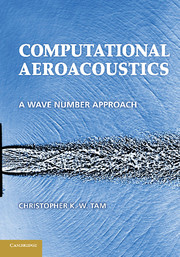Book contents
- Frontmatter
- Contents
- Preface
- 1 Finite Difference Equations
- 2 Spatial Discretization in Wave Number Space
- 3 Time Discretization
- 4 Finite Difference Scheme as Dispersive Waves
- 5 Finite Difference Solution of the Linearized Euler Equations
- 6 Radiation, Outflow, and Wall Boundary Conditions
- 7 The Short Wave Component of Finite Difference Schemes
- 8 Computation of Nonlinear Acoustic Waves
- 9 Advanced Numerical Boundary Treatments
- 10 Time-Domain Impedance Boundary Condition
- 11 Extrapolation and Interpolation
- 12 Multiscales Problems
- Chapter 13 Complex Geometry
- 14 Continuation of a Near-Field Acoustic Solution to the Far Field
- 15 Design of Computational Aeroacoustic Codes
- Appendix A Fourier and Laplace Transforms
- Appendix B The Method of Stationary Phase
- Appendix C The Method of Characteristics
- Appendix D Diffusion Equation
- Appendix E Accelerated Convergence to Steady State
- Appendix F Generation of Broadband Sound Waves with a Prescribed Spectrum by an Energy-Conserving Discretization Method
- Appendix G Sample Computer Programs
- References
- Index
Chapter 13 - Complex Geometry
Published online by Cambridge University Press: 05 October 2012
- Frontmatter
- Contents
- Preface
- 1 Finite Difference Equations
- 2 Spatial Discretization in Wave Number Space
- 3 Time Discretization
- 4 Finite Difference Scheme as Dispersive Waves
- 5 Finite Difference Solution of the Linearized Euler Equations
- 6 Radiation, Outflow, and Wall Boundary Conditions
- 7 The Short Wave Component of Finite Difference Schemes
- 8 Computation of Nonlinear Acoustic Waves
- 9 Advanced Numerical Boundary Treatments
- 10 Time-Domain Impedance Boundary Condition
- 11 Extrapolation and Interpolation
- 12 Multiscales Problems
- Chapter 13 Complex Geometry
- 14 Continuation of a Near-Field Acoustic Solution to the Far Field
- 15 Design of Computational Aeroacoustic Codes
- Appendix A Fourier and Laplace Transforms
- Appendix B The Method of Stationary Phase
- Appendix C The Method of Characteristics
- Appendix D Diffusion Equation
- Appendix E Accelerated Convergence to Steady State
- Appendix F Generation of Broadband Sound Waves with a Prescribed Spectrum by an Energy-Conserving Discretization Method
- Appendix G Sample Computer Programs
- References
- Index
Summary
Computationally, there are two general ways to treat problems with complex geometry. One way is to use unstructured grids. The other is to use overset grids. Overset grids are formed by overlapping structured grids. In this chapter, the basic idea of overset grids methodology and its implementation are discussed.
Basic Concept of Overset Grids
To illustrate the basic idea of overset grids, consider the problem of computing the scattering of acoustic waves by a solid cylinder in two dimensions. In the space around the cylinder, the coordinates of choice for computing the solution is the cylindrical polar coordinates centered at the axis of the cylinder. This coordinate system provides a set of body-fitted coordinates and, hence, a body-fitted mesh when discretized around the cylinder. One significant advantage of using a body-fitted grid is the relative ease in enforcing the no-through-flow wall boundary condition using the ghost point method or other methods. Away from the cylinder, acoustic waves propagate with no preferred direction. The natural coordinate system to use is the Cartesian coordinates. Therefore, to take into account the advantages stated, one may use a polar mesh around the cylinder and a Cartesian mesh away from the cylinder with an overlapping mesh region. The overlapping mesh region is for data transfer from one set of grids to the other and vice versa.
- Type
- Chapter
- Information
- Computational AeroacousticsA Wave Number Approach, pp. 263 - 297Publisher: Cambridge University PressPrint publication year: 2012
- 1
- Cited by



